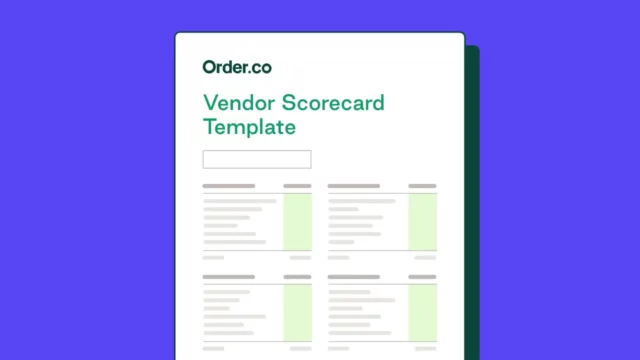VMI in Retail: What’s The Best Way to Manage Inventory?

VMI in Retail: What’s The Best Way to Manage Inventory?
Ordering retail inventory can easily become a full-time job, eating up hours that businesses could better spend on strategic pursuits. Busy retail procurement professionals need a more efficient way to bring inventory in—without letting it collect dust (and consume working capital) sitting on a shelf.
Vendor-managed inventory (VMI) tackles this challenge by using technology and collaboration to streamline operations and prevent costly stockouts or overordering. It helps you take charge of inventory levels, ensuring stock is there exactly when you need it.
Today, we’ll look at the nuts and bolts of VMI, explore who it's good for, and highlight alternative solutions that might be a better fit for a wider range of retailers.
Download the free tool: Vendor Scorecard Template
What is a vendor-managed inventory system in retail?
Vendor-managed inventory (VMI) is a supply chain management agreement in which a vendor oversees a retail buyer’s inventory levels. Unlike traditional inventory management, where retailers order stock based on forecasts, in VMI, the supplier monitors product levels and makes replenishment decisions to optimize stock availability and minimize inventory overstock or “safety stock.”
How VMI in retail systems works
Successful VMI depends on a close, collaborative relationship between supplier and retailer, supported by shared systems that help ensure seamless operations. This model can be challenging for mid-market brands to implement, as it requires a high level of systems integration and cooperation.
In general, the VMI process is as follows:
- Supplier Integration: The buyer must integrate with the supplier's systems. This allows the supplier access to real-time sales data, details on fluctuations in inventory levels, and other relevant information from the retailer’s system.
- Inventory monitoring: Once integrated, the supplier monitors inventory against predefined thresholds, ensuring optimal stock levels to meet demand.
- Forecasting and planning: The supplier's system uses a combination of historical sales data, seasonal trends, and predictive analytics to forecast future demand. Forecasting informs production schedules and helps ensure sufficient product availability.
- Replenishment decisions: The supplier makes decisions about replenishment orders based on forecasting and current inventory levels. These decisions help prevent shortages as well as excess stock.
- Order fulfillment: The supplier prepares and ships orders to replenish the retailer's inventory. This step may involve manufacturing products if items are not readily available.
- Adjustment and inventory optimization: The supplier makes adjustments based on ongoing performance analysis and feedback. This approach ensures the VMI process remains aligned with changing market trends and inventory needs.
- Vendor management: The vendor management process is critical to the success of a VMI relationship. Regular vendor lifecycle management helps ensure contract compliance and strengthens supplier relationships.
Benefits of VMI in retail
VMI offers benefits to both retailers and suppliers, from reduced inventory carrying costs and improved stock availability for the buyer to better production planning and more accurate demand forecasting for the vendor.
Benefits for retailers
Optimized stock levels: VMI ensures inventory remains aligned with current demand forecasts, reducing overstocking or stockouts. This makes it easier to keep the right products available at the right time, improving sales and customer satisfaction.
Inventory cost savings: Well-managed VMI agreements can help reduce excess inventory and storage costs. They also enable retailers to minimize warehousing expenses and eliminate waste from unsold goods, enhancing profitability.
Reduced overhead: Automation of reorders through VMI cuts down on the administrative workload involved in manual ordering and inventory tracking, saving time and decreasing errors and overstock.
More time for strategic work: With the operational burden of inventory management shifted to suppliers, retail teams can concentrate on contributing to growth and customer engagement. More time and budget can go toward marketing, customer service, and strategic planning.
Improved supplier relationships: VMI agreements create partnerships between retailers and suppliers. This leads to better communication, quicker responses to market changes, and enhanced supply chain efficiency.
Benefits for suppliers
Enhanced forecasting accuracy: Direct access to the retailer's sales and inventory data helps suppliers predict product demand more accurately.
Reduced inventory costs: Real-time data reduces inventory costs by preventing excess stock and associated holding costs.
Stronger retailer relationships: The collaborative nature of VMI fosters stronger relationships between suppliers and retailers. Shared goals and mutual benefits help build trust, leading to long-term partnerships and the potential for exclusive agreements.
Increased revenue stability: Effective inventory management helps vendors stabilize and predict revenue while creating more consistent access to supplies for retailers.
Better operational efficiency: Streamlined order processing and logistics operations improve administrative efficiency, enabling suppliers to optimize product production and distribution.
VMI helps suppliers and retailers reduce uncertainty and strengthen their partnerships by aligning business objectives for mutual success.
Risks and drawbacks of VMI in retail
Before considering VMI as a solution for inventory needs, it’s important to understand the model's potential challenges. Relying on the supplier to plan and distribute products can create friction points, making vendor risk management an essential aspect of a successful VMI arrangement.
Here are some factors to consider before entering a VMI agreement.
Retailers relinquish control of their inventory
Retailers may cede too much control over their inventory levels by leaving replenishment decisions to suppliers, potentially leading to misalignments with sales strategies or customer demand.
VMI forces retailers to rely on third-party systems
Both suppliers and retailers depend heavily on the efficiency and reliability of VMI software. Any disruptions or failures in these systems can lead to inventory shortages or surpluses, affecting sales and operations.
Limited flexibility for market changes
VMI agreements might limit retailers' ability to quickly adapt inventory levels in response to sudden market trends or shifts in consumer demand, potentially resulting in lost sales opportunities or a sluggish inventory turnover rate.
Not suitable for all product types
VMI is less effective for products with unpredictable demand patterns, short life cycles, or those requiring specialized handling, making it poorly suited to specific retail segments.
Potential for increased costs
Implementing and maintaining a VMI system can be costly. Initial setup, integration with existing IT infrastructure and the vendor’s electronic data interchange (EDI), and ongoing operation may require significant investment without guaranteed returns.
Scaling may prove challenging
For growing businesses or those with fluctuating demand, scaling a VMI system to accommodate changing needs can be complex and resource-intensive.
Not ideal for modern, decentralized teams
In an era where businesses increasingly adopt lean and agile methodologies, the centralized nature of traditional VMI systems may not align with decentralized decision-making and fast-paced strategic adjustments.
VMI vs. other inventory strategies
VMI is not the only way to maintain inventory levels using outside assistance. When evaluating the usefulness of VMI to your business, compare it against the other options on the market.
| Inventory ownership | Replenishment responsibility | Data sharing & access | |
| Vendor-managed inventory (VMI) | Vendor owns or manages until delivered to the buyer | Vendor monitors stock levels and triggers replenishment | Shared access; vendor receives real-time or periodic usage data from buyer |
| Just-in-time (JIT) | Buyer owns upon delivery | Buyer triggers replenishment based on demand | Minimal sharing; buyer forecasts and controls orders |
| Consignment inventory | Vendor retains ownership until used or sold | Vendor restocks based on usage or scheduling | Buyer may share usage reports, but vendor tracks withdrawals or sales |
| Traditional buyer-managed | Buyer owns upon receipt | Buyer is fully responsible based on internal planning | No vendor access; buyer controls data and forecasting |
Best practices for VMI implementation
For companies committed to the VMI replenishment process, a well-established workflow is the best way to achieve desired results for inventory management and vendor relationships. Consider these best practices when committing to VMI for inventory management.
1. Start small
Beginning with small, manageable VMI projects allows companies to navigate the complexities of vendor-managed inventory in a controlled environment. This approach helps iron out procedural kinks, builds trust between partners, and enhances system capabilities in a manageable way. As confidence and expertise grow, scaling is smoother and more strategic, leveraging early successes for broader implementation.
2. Choose partners carefully
Entering a VMI agreement with vendor partners calls for careful due diligence. Since a good VMI program can connect you with reliable and compatible suppliers, vendor selection is essential to the efficiency and success of your inventory management system. To ensure long-term success, ongoing supplier evaluation processes are necessary for maintaining alignment of your company's values and operational standards with those of your partners.
3. Define shared KPIs
Collaborating on mutually agreed-upon performance metrics is critical for maintaining the success of a VMI relationship. It allows both parties to monitor progress, identify areas for improvement, and make necessary adjustments. Establishing key performance indicators early on creates accountability and well-defined parameters that help foster a proactive approach to achieving shared goals.
4. Integrate systems
Systems integration is foundational to the success of VMI arrangements since these projects rely on close and consistent communication and data exchange between partners. Integration enhances efficiency, reduces errors, and allows suppliers to provide real-time inventory adjustments and forward-thinking stocking decisions.
5. Consider your options
VMI isn’t the only model that guarantees sound inventory management. While VMI can be successful under the right conditions and with the correct systems, there may be easier ways to achieve the same results. Take time to analyze your procurement function and understand its goal. Use this as the basis of comparison for other replenishment models.
Do you even need VMI in retail?
While VMI presents a streamlined solution for inventory management, it's not a silver bullet for all retail challenges. Mid-market retailers and those operating multiple locations with limited operational staff may find the VMI model creates more problems than it solves.
- Retail businesses face unique demands that require more tailored and agile inventory solutions. The assumption that VMI is universally beneficial overlooks the complexity of managing inventory across diverse geographical locations and consumer bases.
- Reliance on suppliers for inventory decisions might not align with your strategic goals or market needs. This may lead to overstocking or stockouts that cost money and damage customer relationships.
- Small businesses may lack the necessary infrastructure to integrate with larger vendors. This puts a damper on VMI’s perceived efficiency benefits and may increase errors rather than reduce them. VMI has its advantages, but other options offer its benefits without the same complexity and loss of control.
A smarter take on VMI in retail with Order.co
For many businesses, VMI may solve one problem while creating friction elsewhere. Order.co offers the benefits of the VMI approach without its downsides. As an AI-powered procurement system, it deftly manages the end-to-end procurement process with greater flexibility and control.
Order.co offers centralized purchase order creation, customizable workflows, automated approvals, intelligent invoice processing, and seamless payment solutions. It streamlines operations and gives buyers at every location real-time visibility and control—without rigidity or wasted spending.
Unlike traditional VMI systems that add complexity to inventory management, Order.co takes a smarter approach with AI-powered strategic sourcing and a curated product catalog. Built on Order.co’s proprietary model, it empowers front-end teams to purchase what they need with ease while delivering tailored product suggestions to improve the buying experience. By enabling more agile, adaptable product and vendor sourcing decisions alongside tighter control over inventory levels, Order.co helps reduce inventory costs and strengthen supplier relationships—all while keeping pace with shifting market and sales trends.
To learn more about managing inventory for your retail business with the ease of VMI and the adaptability of a next-generation procurement system, get a demo of Order.co.
Get started
Schedule a demo to see how Order.co can simplify buying for your business.
"*" indicates required fields



